tow Lancia Musa 2008 Owner handbook (in English)
[x] Cancel search | Manufacturer: LANCIA, Model Year: 2008, Model line: Musa, Model: Lancia Musa 2008Pages: 218, PDF Size: 3.68 MB
Page 140 of 218
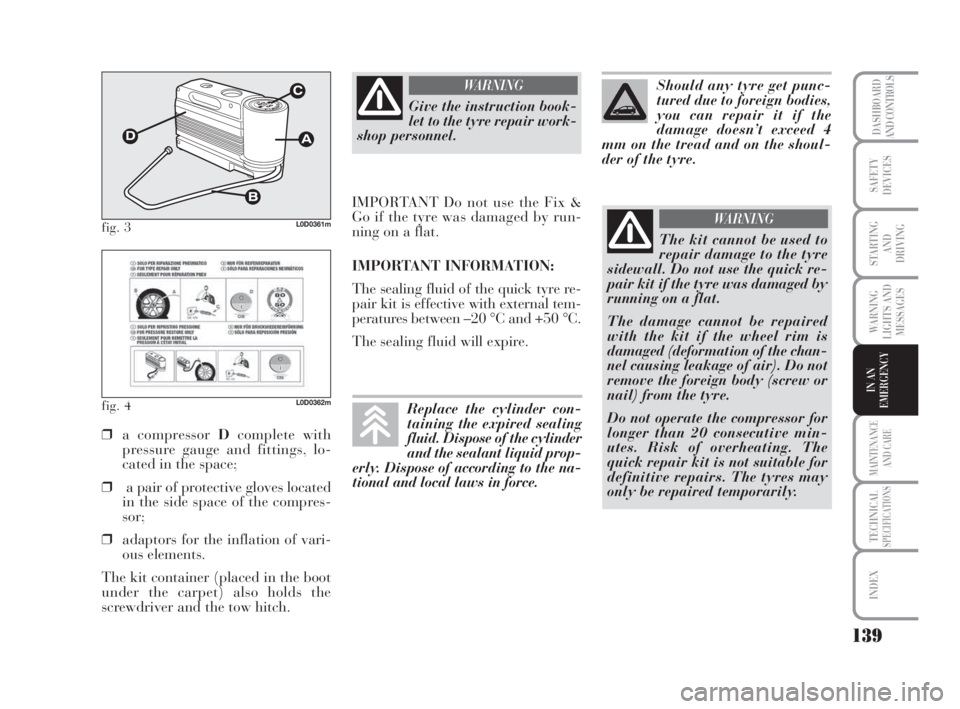
139
WARNING
LIGHTS AND
MESSAGES
MAINTENANCE
AND CARE
TECHNICALSPECIFICATIONS
INDEX
DASHBOARD
AND CONTROLS
SAFETY
DEVICES
STARTING
AND
DRIVING
IN AN
EMERGENCY
fig. 3L0D0361m
fig. 4L0D0362m
❒a compressor Dcomplete with
pressure gauge and fittings, lo-
cated in the space;
❒a pair of protective gloves located
in the side space of the compres-
sor;
❒adaptors for the inflation of vari-
ous elements.
The kit container (placed in the boot
under the carpet) also holds the
screwdriver and the tow hitch.
Give the instruction book-
let to the tyre repair work-
shop personnel.
WARNING
IMPORTANT Do not use the Fix &
Go if the tyre was damaged by run-
ning on a flat.
IMPORTANT INFORMATION:
The sealing fluid of the quick tyre re-
pair kit is effective with external tem-
peratures between –20 °C and +50 °C.
The sealing fluid will expire.
The kit cannot be used to
repair damage to the tyre
sidewall. Do not use the quick re-
pair kit if the tyre was damaged by
running on a flat.
The damage cannot be repaired
with the kit if the wheel rim is
damaged (deformation of the chan-
nel causing leakage of air). Do not
remove the foreign body (screw or
nail) from the tyre.
Do not operate the compressor for
longer than 20 consecutive min-
utes. Risk of overheating. The
quick repair kit is not suitable for
definitive repairs. The tyres may
only be repaired temporarily.
WARNING
Should any tyre get punc-
tured due to foreign bodies,
you can repair it if the
damage doesn’t exceed 4
mm on the tread and on the shoul-
der of the tyre.
Replace the cylinder con-
taining the expired sealing
fluid. Dispose of the cylinder
and the sealant liquid prop-
erly. Dispose of according to the na-
tional and local laws in force.
135-164 MUSA 3ed GB 12-11-2007 11:38 Pagina 139
Page 148 of 218
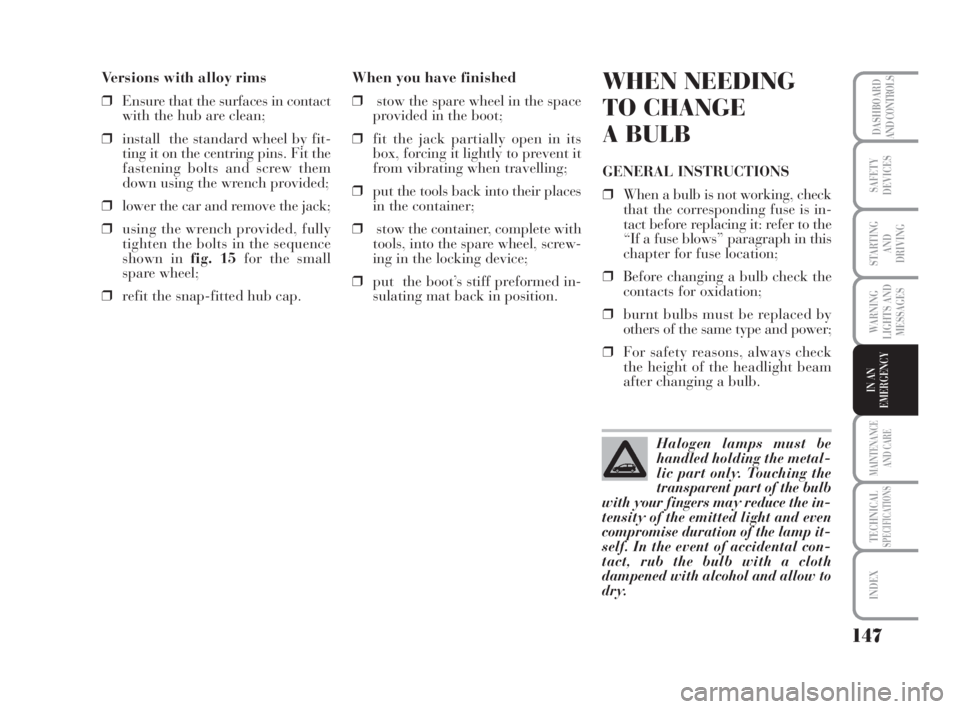
147
WARNING
LIGHTS AND
MESSAGES
MAINTENANCE
AND CARE
TECHNICALSPECIFICATIONS
INDEX
DASHBOARD
AND CONTROLS
SAFETY
DEVICES
STARTING
AND
DRIVING
IN AN
EMERGENCY
Versions with alloy rims
❒Ensure that the surfaces in contact
with the hub are clean;
❒install the standard wheel by fit-
ting it on the centring pins. Fit the
fastening bolts and screw them
down using the wrench provided;
❒lower the car and remove the jack;
❒using the wrench provided, fully
tighten the bolts in the sequence
shown in fig. 15for the small
spare wheel;
❒refit the snap-fitted hub cap.When you have finished
❒stow the spare wheel in the space
provided in the boot;
❒ fit the jack partially open in its
box, forcing it lightly to prevent it
from vibrating when travelling;
❒put the tools back into their places
in the container;
❒stow the container, complete with
tools, into the spare wheel, screw-
ing in the locking device;
❒put the boot’s stiff preformed in-
sulating mat back in position.WHEN NEEDING
TO CHANGE
A BULB
GENERAL INSTRUCTIONS
❒When a bulb is not working, check
that the corresponding fuse is in-
tact before replacing it: refer to the
“If a fuse blows” paragraph in this
chapter for fuse location;
❒Before changing a bulb check the
contacts for oxidation;
❒burnt bulbs must be replaced by
others of the same type and power;
❒For safety reasons, always check
the height of the headlight beam
after changing a bulb.
Halogen lamps must be
handled holding the metal-
lic part only. Touching the
transparent part of the bulb
with your fingers may reduce the in-
tensity of the emitted light and even
compromise duration of the lamp it-
self. In the event of accidental con-
tact, rub the bulb with a cloth
dampened with alcohol and allow to
dry.
135-164 MUSA 3ed GB 12-11-2007 11:39 Pagina 147
Page 164 of 218
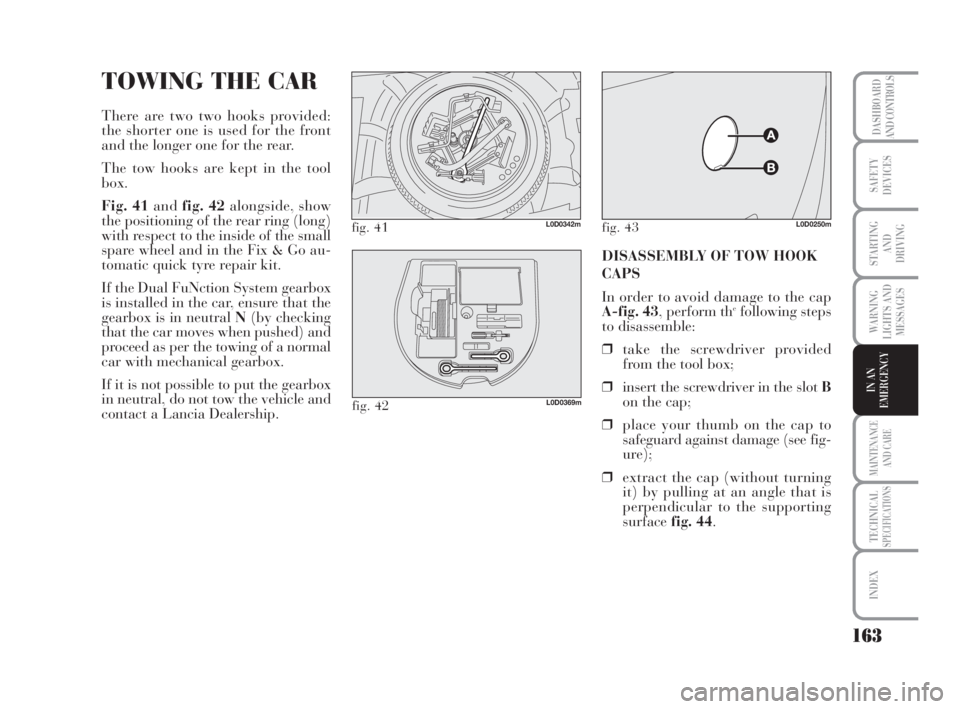
163
WARNING
LIGHTS AND
MESSAGES
MAINTENANCE
AND CARE
TECHNICALSPECIFICATIONS
INDEX
DASHBOARD
AND CONTROLS
SAFETY
DEVICES
STARTING
AND
DRIVING
IN AN
EMERGENCY
TOWING THE CAR
There are two two hooks provided:
the shorter one is used for the front
and the longer one for the rear.
The tow hooks are kept in the tool
box.
Fig. 41 andfig. 42 alongside, show
the positioning of the rear ring (long)
with respect to the inside of the small
spare wheel and in the Fix & Go au-
tomatic quick tyre repair kit.
If the Dual FuNction System gearbox
is installed in the car, ensure that the
gearbox is in neutral N(by checking
that the car moves when pushed) and
proceed as per the towing of a normal
car with mechanical gearbox.
If it is not possible to put the gearbox
in neutral, do not tow the vehicle and
contact a Lancia Dealership.
fig. 41L0D0342m
fig. 42L0D0369m
DISASSEMBLY OF TOW HOOK
CAPS
In order to avoid damage to the cap
A-fig. 43, perform th
efollowing steps
to disassemble:
❒take the screwdriver provided
from the tool box;
❒insert the screwdriver in the slot B
on the cap;
❒place your thumb on the cap to
safeguard against damage (see fig-
ure);
❒extract the cap (without turning
it) by pulling at an angle that is
perpendicular to the supporting
surfacefig. 44.
fig. 43L0D0250m
135-164 MUSA 3ed GB 12-11-2007 11:39 Pagina 163
Page 165 of 218
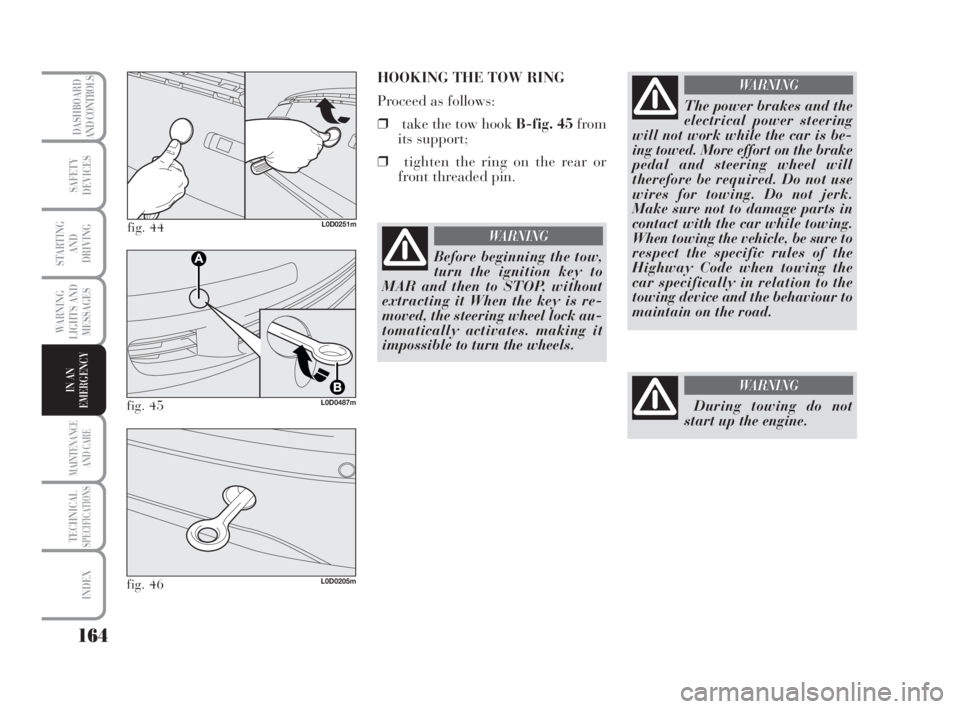
164
WARNING
LIGHTS AND
MESSAGES
MAINTENANCE
AND CARE
TECHNICALSPECIFICATIONS
INDEX
DASHBOARD
AND CONTROLS
SAFETY
DEVICES
STARTING
AND
DRIVING
IN AN
EMERGENCY
fig. 44L0D0251m
HOOKING THE TOW RING
Proceed as follows:
❒take the tow hook B-fig. 45from
its support;
❒tighten the ring on the rear or
front threaded pin.
fig. 45L0D0487m
fig. 46L0D0205m
The power brakes and the
electrical power steering
will not work while the car is be-
ing towed. More effort on the brake
pedal and steering wheel will
therefore be required. Do not use
wires for towing. Do not jerk.
Make sure not to damage parts in
contact with the car while towing.
When towing the vehicle, be sure to
respect the specific rules of the
Highway Code when towing the
car specifically in relation to the
towing device and the behaviour to
maintain on the road.
WARNING
Before beginning the tow,
turn the ignition key to
MAR and then to STOP, without
extracting it When the key is re-
moved, the steering wheel lock au-
tomatically activates. making it
impossible to turn the wheels.
WARNING
During towing do not
start up the engine.
WARNING
135-164 MUSA 3ed GB 12-11-2007 11:39 Pagina 164
Page 167 of 218
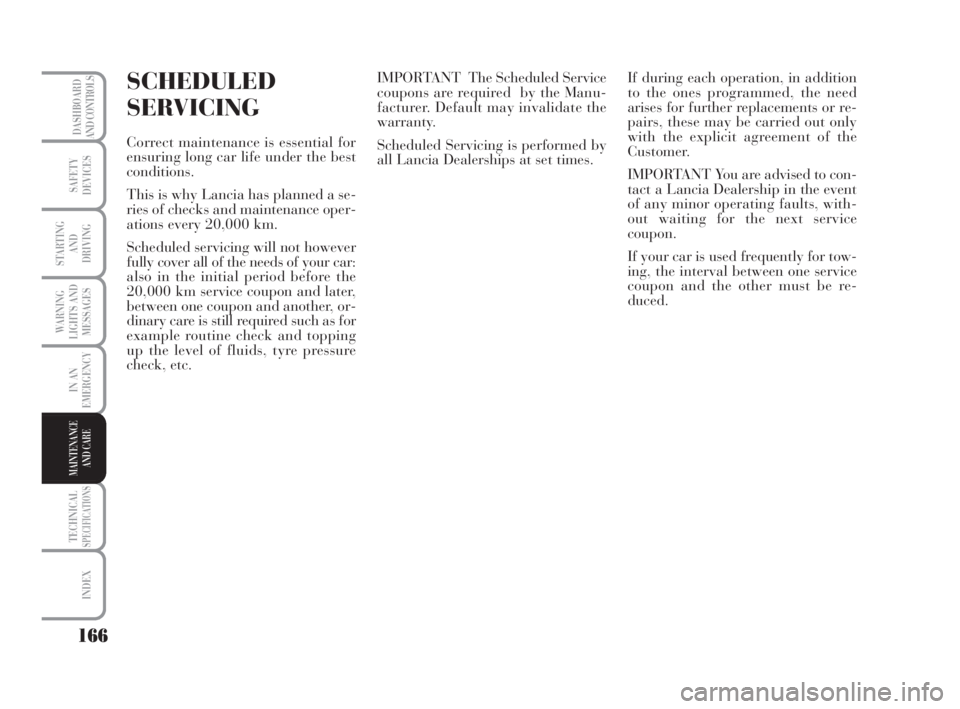
166
WARNING
LIGHTS AND
MESSAGES
TECHNICALSPECIFICATIONS
INDEX
DASHBOARD
AND CONTROLS
SAFETY
DEVICES
STARTING
AND
DRIVING
IN AN
EMERGENCY
MAINTENANCE
AND CARE
SCHEDULED
SERVICING
Correct maintenance is essential for
ensuring long car life under the best
conditions.
This is why Lancia has planned a se-
ries of checks and maintenance oper-
ations every 20,000 km.
Scheduled servicing will not however
fully cover all of the needs of your car:
also in the initial period before the
20,000 km service coupon and later,
between one coupon and another, or-
dinary care is still required such as for
example routine check and topping
up the level of fluids, tyre pressure
check, etc. IMPORTANT The Scheduled Service
coupons are required by the Manu-
facturer. Default may invalidate the
warranty.
Scheduled Servicing is performed by
all Lancia Dealerships at set times. If during each operation, in addition
to the ones programmed, the need
arises for further replacements or re-
pairs, these may be carried out only
with the explicit agreement of the
Customer.
IMPORTANT You are advised to con-
tact a Lancia Dealership in the event
of any minor operating faults, with-
out waiting for the next service
coupon.
If your car is used frequently for tow-
ing, the interval between one service
coupon and the other must be re-
duced.
165-186 MUSA 3ed GB 12-11-2007 11:39 Pagina 166
Page 169 of 218
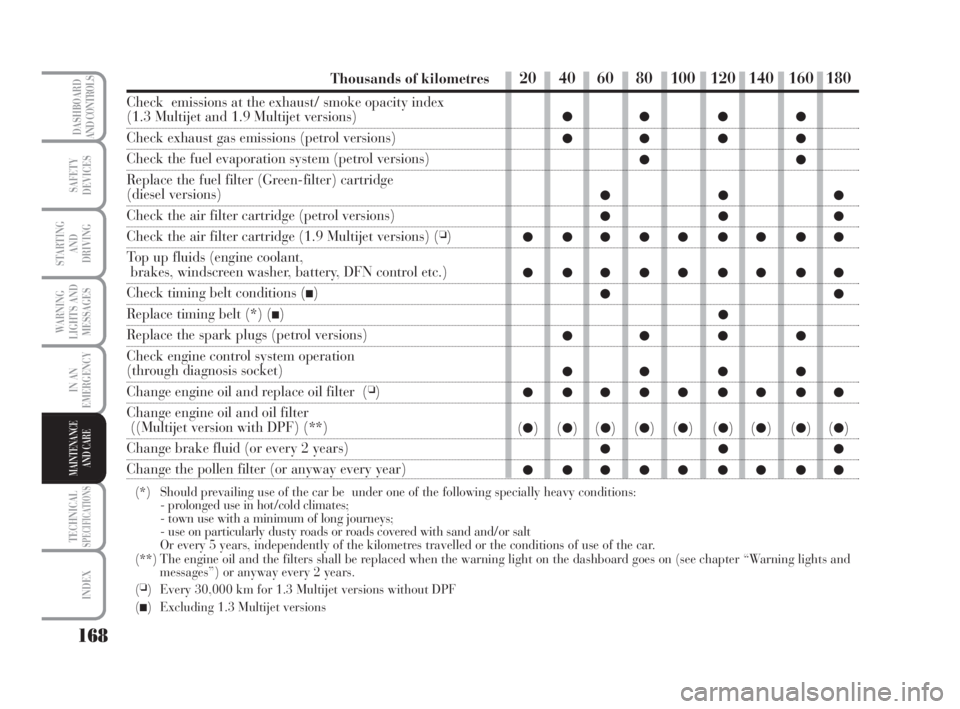
168
WARNING
LIGHTS AND
MESSAGES
TECHNICALSPECIFICATIONS
INDEX
DASHBOARD
AND CONTROLS
SAFETY
DEVICES
STARTING
AND
DRIVING
IN AN
EMERGENCY
MAINTENANCE
AND CARE
Thousands of kilometres
Check emissions at the exhaust/ smoke opacity index
(1.3 Multijet and 1.9 Multijet versions)
Check exhaust gas emissions (petrol versions)
Check the fuel evaporation system (petrol versions)
Replace the fuel filter (Green-filter) cartridge
(diesel versions)
Check the air filter cartridge (petrol versions)
Check the air filter cartridge (1.9 Multijet versions) (❏)
Top up fluids (engine coolant,
brakes, windscreen washer, battery, DFN control etc.)
Check timing belt conditions (■)
Replace timing belt (*) (■)
Replace the spark plugs (petrol versions)
Check engine control system operation
(through diagnosis socket)
Change engine oil and replace oil filter (❏)
Change engine oil and oil filter
((Multijet version with DPF) (**)
Change brake fluid (or every 2 years)
Change the pollen filter (or anyway every year)
(*) Should prevailing use of the car be under one of the following specially heavy conditions:
- prolonged use in hot/cold climates;
- town use with a minimum of long journeys;
- use on particularly dusty roads or roads covered with sand and/or salt
Or every 5 years, independently of the kilometres travelled or the conditions of use of the car.
(**) The engine oil and the filters shall be replaced when the warning light on the dashboard goes on (see chapter “Warning lights and
messages”) or anyway every 2 years.
(
❏) Every 30,000 km for 1.3 Multijet versions without DPF
(
■) Excluding 1.3 Multijet versions
20 40 60 80 100 120 140 160 180
●● ● ●
●● ● ●
●●
●●●
●●●
●●●●● ●●●●
●●●●● ●●●●
●●
●
●● ● ●
●● ● ●
●●●●● ●●●●
(●)(●)(●)(●)(●)(●)(●)(●)(●)
●●●
●●●●● ●●●●
165-186 MUSA 3ed GB 12-11-2007 11:39 Pagina 168
Page 170 of 218
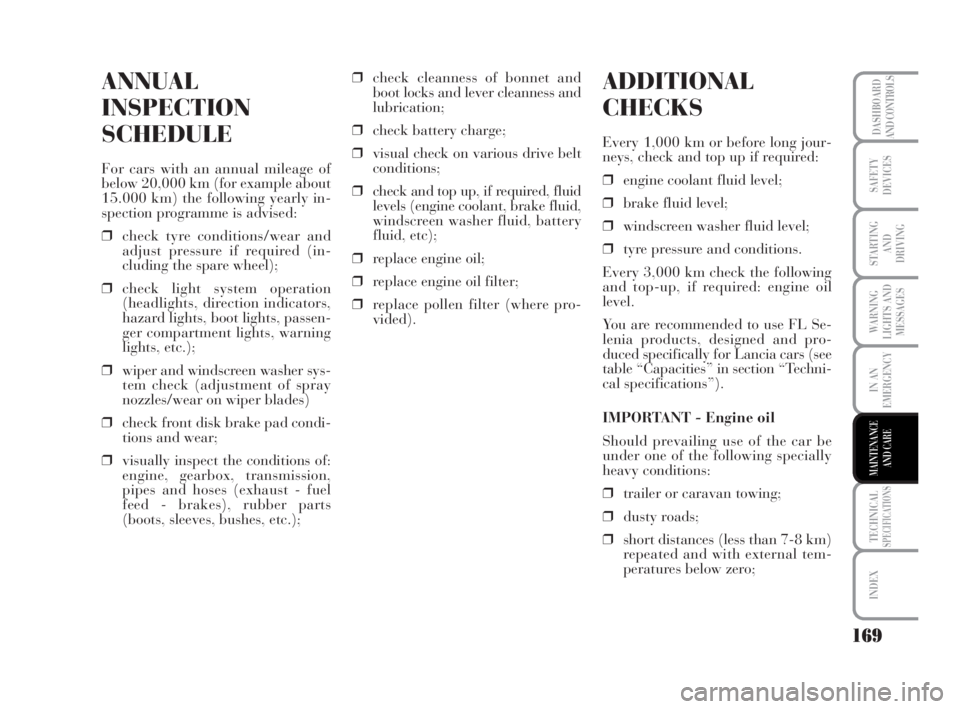
169
WARNING
LIGHTS AND
MESSAGES
TECHNICALSPECIFICATIONS
INDEX
DASHBOARD
AND CONTROLS
SAFETY
DEVICES
STARTING
AND
DRIVING
IN AN
EMERGENCY
MAINTENANCE
AND CARE
ANNUAL
INSPECTION
SCHEDULE
For cars with an annual mileage of
below 20,000 km (for example about
15.000 km) the following yearly in-
spection programme is advised:
❒check tyre conditions/wear and
adjust pressure if required (in-
cluding the spare wheel);
❒check light system operation
(headlights, direction indicators,
hazard lights, boot lights, passen-
ger compartment lights, warning
lights, etc.);
❒wiper and windscreen washer sys-
tem check (adjustment of spray
nozzles/wear on wiper blades)
❒check front disk brake pad condi-
tions and wear;
❒visually inspect the conditions of:
engine, gearbox, transmission,
pipes and hoses (exhaust - fuel
feed - brakes), rubber parts
(boots, sleeves, bushes, etc.);❒check cleanness of bonnet and
boot locks and lever cleanness and
lubrication;
❒check battery charge;
❒visual check on various drive belt
conditions;
❒check and top up, if required, fluid
levels (engine coolant, brake fluid,
windscreen washer fluid, battery
fluid, etc);
❒replace engine oil;
❒replace engine oil filter;
❒replace pollen filter (where pro-
vided).
ADDITIONAL
CHECKS
Every 1,000 km or before long jour-
neys, check and top up if required:
❒engine coolant fluid level;
❒brake fluid level;
❒windscreen washer fluid level;
❒tyre pressure and conditions.
Every 3,000 km check the following
and top-up, if required: engine oil
level.
You are recommended to use FL Se-
lenia products, designed and pro-
duced specifically for Lancia cars (see
table “Capacities” in section “Techni-
cal specifications”).
IMPORTANT - Engine oil
Should prevailing use of the car be
under one of the following specially
heavy conditions:
❒trailer or caravan towing;
❒dusty roads;
❒short distances (less than 7-8 km)
repeated and with external tem-
peratures below zero;
165-186 MUSA 3ed GB 12-11-2007 11:39 Pagina 169
Page 201 of 218
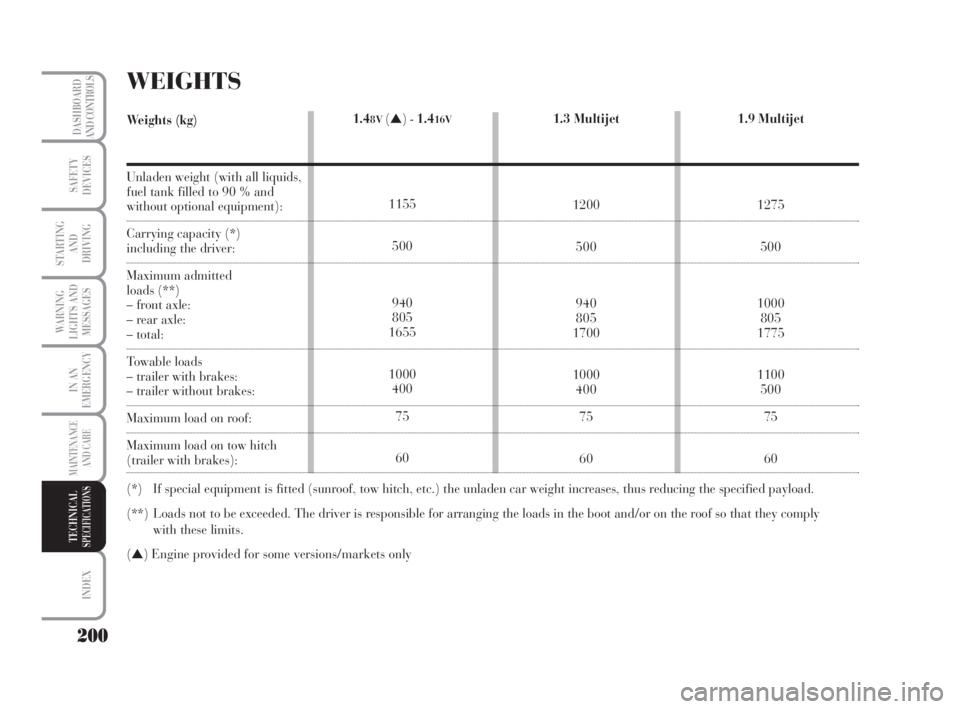
200
WARNING
LIGHTS AND
MESSAGES
INDEX
DASHBOARD
AND CONTROLS
SAFETY
DEVICES
STARTING
AND
DRIVING
IN AN
EMERGENCY
MAINTENANCE
AND CARE
TECHNICALSPECIFICATIONS
1.48V(▲)-1.416V
1155
500
940
805
1655
1000
400
75
601.3 Multijet
1200
500
940
805
1700
1000
400
75
601.9 Multijet
1275
500
1000
805
1775
1100
500
75
60
WEIGHTS
Weights (kg)
Unladen weight (with all liquids,
fuel tank filled to 90 % and
without optional equipment):
Carrying capacity (*)
including the driver:
Maximum admitted
loads (**)
– front axle:
– rear axle:
– total:
Towable loads
– trailer with brakes:
– trailer without brakes:
Maximum load on roof:
Maximum load on tow hitch
(trailer with brakes):
(*) If special equipment is fitted (sunroof, tow hitch, etc.) the unladen car weight increases, thus reducing the specified payload.
(**) Loads not to be exceeded. The driver is responsible for arranging the loads in the boot and/or on the roof so that they comply
with these limits.
(
▲) Engine provided for some versions/markets only
187-205 MUSA 3ed GB 12-11-2007 11:40 Pagina 200
Page 209 of 218
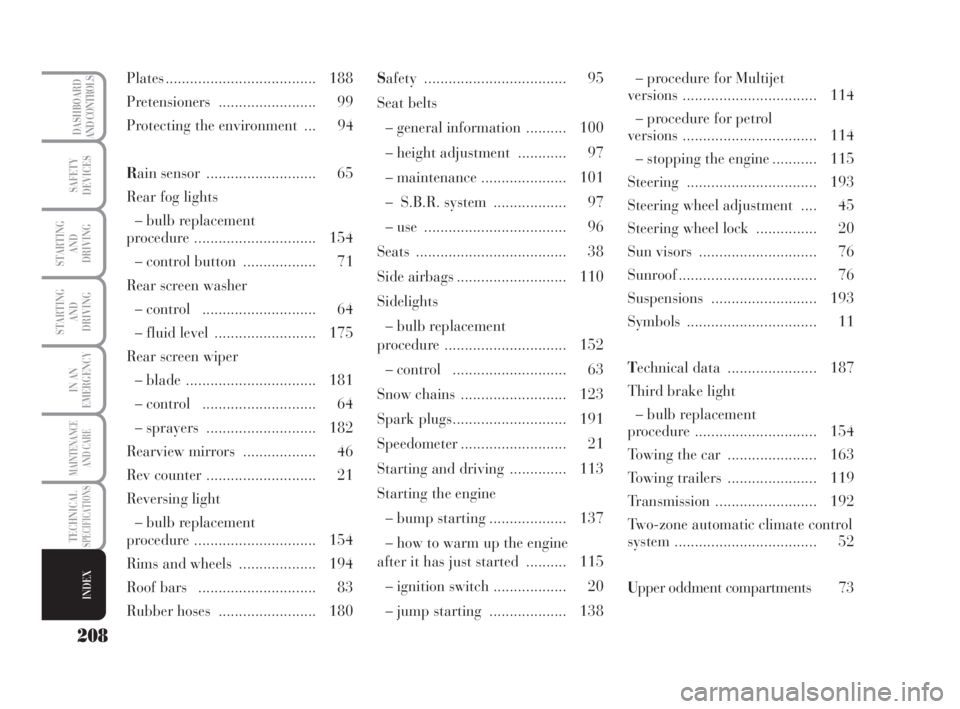
Plates ..................................... 188
Pretensioners ........................ 99
Protecting the environment ... 94
Rain sensor ........................... 65
Rear fog lights
– bulb replacement
procedure .............................. 154
– control button .................. 71
Rear screen washer
– control ............................ 64
– fluid level ......................... 175
Rear screen wiper
– blade ................................ 181
– control ............................ 64
– sprayers ........................... 182
Rearview mirrors .................. 46
Rev counter ........................... 21
Reversing light
– bulb replacement
procedure .............................. 154
Rims and wheels ................... 194
Roof bars ............................. 83
Rubber hoses ........................ 180Safety ................................... 95
Seat belts
– general information .......... 100
– height adjustment ............ 97
– maintenance ..................... 101
– S.B.R. system .................. 97
– use ................................... 96
Seats ..................................... 38
Side airbags ........................... 110
Sidelights
– bulb replacement
procedure .............................. 152
– control ............................ 63
Snow chains .......................... 123
Spark plugs............................ 191
Speedometer .......................... 21
Starting and driving .............. 113
Starting the engine
– bump starting ................... 137
– how to warm up the engine
after it has just started .......... 115
– ignition switch .................. 20
– jump starting ................... 138– procedure for Multijet
versions ................................. 114
– procedure for petrol
versions ................................. 114
– stopping the engine ........... 115
Steering ................................ 193
Steering wheel adjustment .... 45
Steering wheel lock ............... 20
Sun visors ............................. 76
Sunroof .................................. 76
Suspensions .......................... 193
Symbols ................................ 11
Technical data ...................... 187
Third brake light
– bulb replacement
procedure .............................. 154
Towing the car ...................... 163
Towing trailers ...................... 119
Transmission ......................... 192
Two-zone automatic climate control
system ................................... 52
Upper oddment compartments 73
208
STARTING
AND
DRIVING
DASHBOARD
AND CONTROLS
SAFETY
DEVICES
STARTING
AND
DRIVING
IN AN
EMERGENCY
MAINTENANCE
AND CARE
TECHNICALSPECIFICATIONS
INDEX
206-216 MUSA 3ed GB 12-11-2007 11:40 Pagina 208
Page 211 of 218
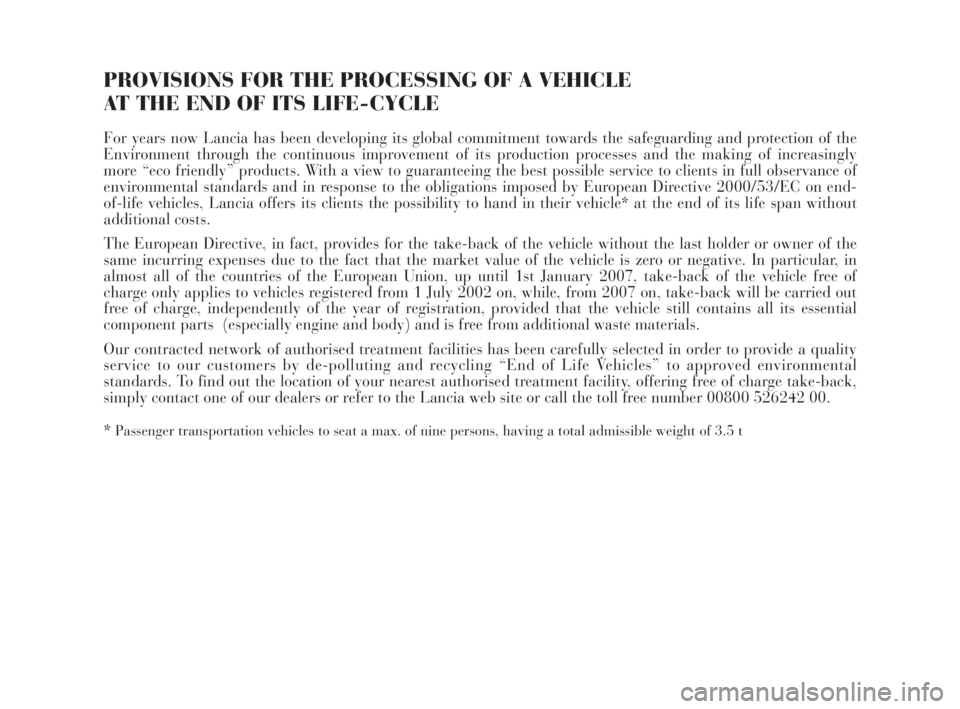
PROVISIONS FOR THE PROCESSING OF A VEHICLE
AT THE END OF ITS LIFE-CYCLE
For years now Lancia has been developing its global commitment towards the safeguarding and protection of the
Environment through the continuous improvement of its production processes and the making of increasingly
more “eco friendly” products. With a view to guaranteeing the best possible service to clients in full observance of
environmental standards and in response to the obligations imposed by European Directive 2000/53/EC on end-
of-life vehicles, Lancia offers its clients the possibility to hand in their vehicle* at the end of its life span without
additional costs.
The European Directive, in fact, provides for the take-back of the vehicle without the last holder or owner of the
same incurring expenses due to the fact that the market value of the vehicle is zero or negative. In particular, in
almost all of the countries of the European Union, up until 1st January 2007, take-back of the vehicle free of
charge only applies to vehicles registered from 1 July 2002 on, while, from 2007 on, take-back will be carried out
free of charge, independently of the year of registration, provided that the vehicle still contains all its essential
component parts (especially engine and body) and is free from additional waste materials.
Our contracted network of authorised treatment facilities has been carefully selected in order to provide a quality
service to our customers by de-polluting and recycling “End of Life Vehicles” to approved environmental
standards. To find out the location of your nearest authorised treatment facility, offering free of charge take-back,
simply contact one of our dealers or refer to the Lancia web site or call the toll free number 00800 526242 00.
*
Passenger transportation vehicles to seat a max. of nine persons, having a total admissible weight of 3.5 t
206-216 MUSA 3ed GB 12-11-2007 11:40 Pagina 210